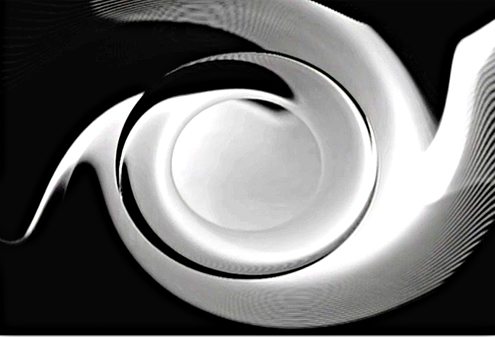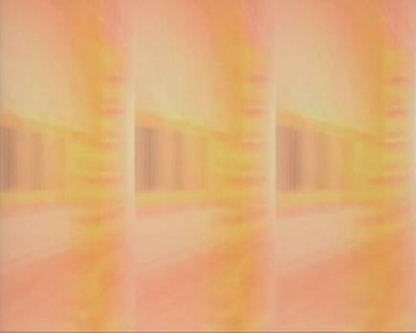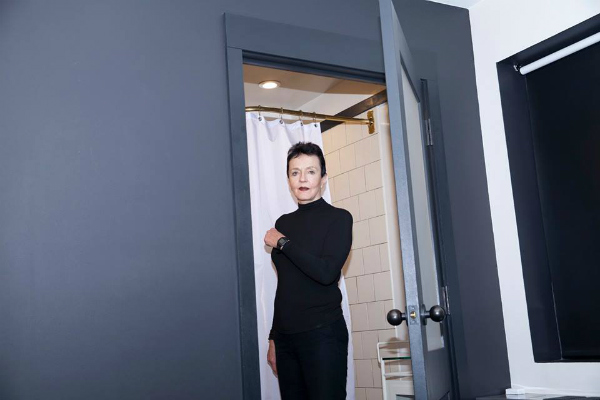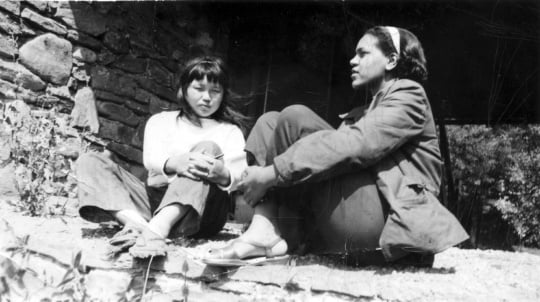Recalling the night a neighboring property in her small Midwestern hometown went up in flames, Sara Hornbacher vividly describes not a spectacle of combusting wood, dancing embers, and choking smoke, but the play of firelight on the walls of her white-washed childhood home. The firelight’s capacity to transform the domestic surface into primal abstraction has proven to be an indelible influence on Hornbacher’s work.
We’re seated in the artist’s intimate studio at the Atlanta Contemporary. It’s a cloudless March afternoon, but you wouldn’t know it from the inside of Hornbacher’s space. The blinds are drawn, and, like a young Sara years earlier, we’re bathed in a shifting, totalizing light — this time from her work EURO playing on a wall opposite our black rubber wire chairs. We’re reflecting on her pioneering career in the realm of site-specific, environmental art-making as she prepares for an upcoming collaborative exhibition with artist Monica Duncan, opening March 15 at the Contemporary.
If you’re somehow just hearing of Hornbacher, you’re likely a younger art fan, and certainly not alone. After taking a short respite from studio work, the Atlanta-based artist has reemerged onto the national art scene, exhibiting work in the 2016 retrospective SIGNAL TO CODE at Cornell University; Anti Bodies at MoMA PS1 (January 2018); and Interference, an upcoming collaborative exhibition opening March 15 at Atlanta Contemporary.
Blinking away the afternoon sun, we step into the neighboring studio where Interference will take place. Hornbacher’s collaborator, her longtime friend Monica Duncan, is an artist working in video and performance. The two first met over 15 years ago at the Experimental Television Center and have both long been involved in the experimental Signal Culture residency program in Owego, New York, yet this month’s collaboration will be the first between them.
The resulting exhibition, Interference, will consist of a site-specific projection environment quite literally blending the two artists’ practices; Hornbacher and Duncan plan to cross multiple projectors to create layered videos composed of material from each of their massive archives of images. The project is improvisatory, a proposition whose final realization will only be clear on the opening night.
At various points in our conversation, it becomes clear that the light of that Midwestern house fire, along with the particular light of the North American prairie—an indelible origin point for generations of American and Canadian artists—forms the connective tissue linking Hornbacher’s artistic origins, storied career, and new work. Light—and its absence—seem to mark each significant chapter of the artist’s life and work.

In 1974, the young artist found herself in Minneapolis with free lodging and a ticket to see the landmark Projected Images exhibition at the Walker Art Center. The show, a survey of projected works by artists Peter Campus, Rockne Krebs, Paul Sharits, Michael Snow, Ted Victoria, and Robert Whitman, centered around the manipulation of the element that had captured Hornbacher’s imagination all those years earlier. The experience would prove life-altering, not unlike a first experience of drugs.
Synchronoussoundtracks, Paul Sharits’s piece in that show, occasioned a thunderclap of mutual recognition in Hornbacher. Particularly moving to her was the ease with which any viewer could approach these immersive installations of light and come away changed. A rewarding relationship with the work “would have nothing to do with prior experience, language, or background.”
“I asked myself, ‘How could I make this?’” Luckily for Hornbacher, many of the exhibition’s artists were in Minneapolis that week, and she soon connected with Sharits over their shared interest in structuralist ideas. At the time, Hornbacher was just finishing her undergraduate degree in fine art in Moorhead, Minnesota, and hoping to continue her studies in graduate school. Experiencing this groundbreaking work left her wondering where could she go to learn the secret of this new form of art-making. Sharits would prove a valuable guide. “Paul was like a pied piper,” Hornbacher jokes.
Sharits recommended she apply to the university that employed him, the State University of New York—Buffalo, then an emerging hotbed of avant-garde scholarship and discourse. The home of initiatives like the Experimental Television Center in Binghamton and SUNY-Buffalo’s Center for Media Study, Western New York was rife with experimentation in the emerging field of electronic media. After receiving a full-scholarship, Hornbacher soon enrolled as a graduate fellow.

The 1970s were a time of dissolving academic and institutional boundaries, with artists like Hornbacher folding fields as diverse as biology and architecture into their practices, and theorists calling for the deconstruction of old hierarchies and disciplinary divisions. At the experimental SUNY school, every discipline, it seemed, was up for dissection. Luminaries associated with structuralist thinking were frequent lecturers in Buffalo’s many centers of learning and experimentation. “All the great thinkers came through Buffalo—I saw Baudrilliard, Barthes, Deleuze. There was never enough time to attend all the events taking place each night.”
In her early work in film and video, Hornbacher’s examinations of light found conceptual support in the philosophies of structuralism and post-structuralism, methodologies that highlight the importance of context, underlying systems, and interrelations between diverse subjects in deciphering cultural phenomena. Akin to Ellsworth Kelly’s transformation of color into subject, Hornbacher’s decision to position light as subject was a move that blurred the line between content and context. As the principal means by which we are able or unable to see the phenomena around us, light is an inescapable stage for any viewing experience. In a structuralist twist elegant in its simplicity, Hornbacher found she could dismantle the boundary between context into content simply by positioning light as subject. It’s a move she would perform, in various guises, in installations for decades to come.
While living in New York during the 1980s and 1990s, Hornbacher participated in early exhibitions of video art at venues such as Anthology Film Archives and The Kitchen. In 1985 she served as guest editor of the first special issue of the CAA Art Journal addressing video, and in 1989 she was included in the exhibition Image World: Art and Media Culture at the Whitney Museum. After teaching at the School of Visual Arts for eight years, in 1994 Hornbacher relocated to Atlanta, where she served as Video Chair at the Atlanta College of Art until the school’s closure in 2006.

Much has been said of Hornbacher’s striking appearance: a tall figure, slender, eyes wide, in clothes the same shade of black as her closely-shorn hair. While her appearance evokes iconic figures from multiple eras, she reminds me of the regal automaton Maria from Fritz Lang’s 1927 film Metropolis. Though Hornbacher shares none of Maria’s destructive aims, each represents a compelling model for engaging the world through and beyond technological means.
With Emory scholar John Johnston going so far as describing the artist as “the Hornbacher Machine,” a cyborgian element pervades her work—not just in her embrace of media interfaces or her remarkable ability to ride waves of technological innovation over the years—but in the manner in which the division between disparate subjects are blurred, implanted one within the other like a computer chip under skin. Hornbacher works like EURO depict a concatenation of camera and hand, hand and eye, eye and camera, as the artist documents two exhibitions to dizzying effect: Fred Wilson’s 2003 Venice Biennale presentation Speak of Me as I Am and Katharina Fritsch’s 1991-92 installation Man and Mouse.
Though many of Hornbacher’s works depict machinery, her artwork never feels scrubbed of human touch or spared by contemporary history. While falling squarely into the structuralist tradition from which the artist has always drawn, works like Numerical Studies III also create phantasmagorical visuals that evoke something between the gauzy credits of I Love Lucy and a human soul. In observing the interiority of machines, viewers may find themselves moving toward a space beyond technology and into a meditative spell.
Interference opens Thursday, March 15 at 7 pm in Studio 10 at Atlanta Contemporary.





